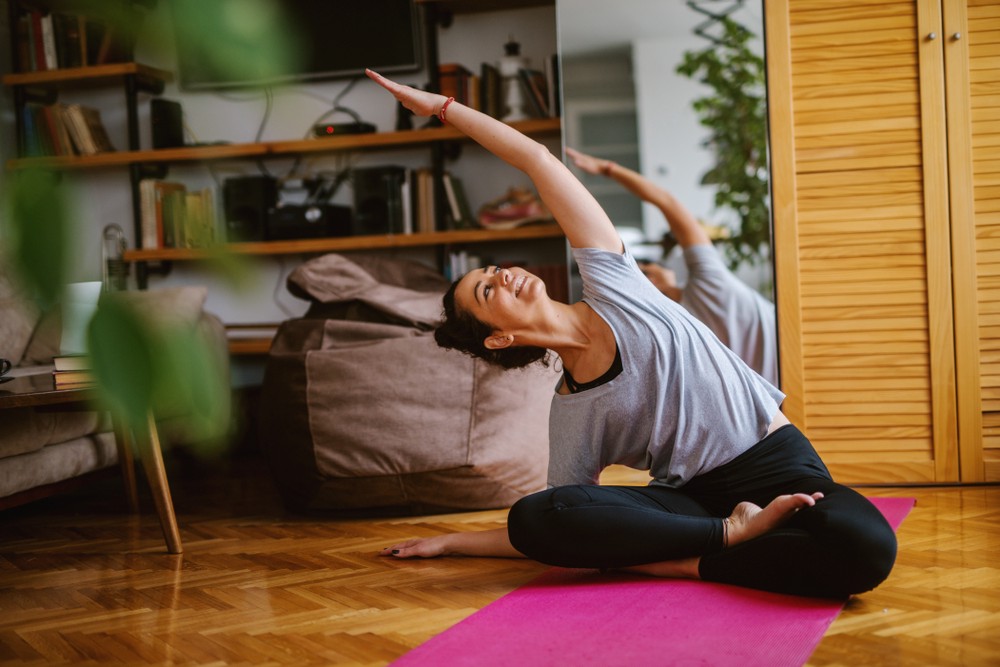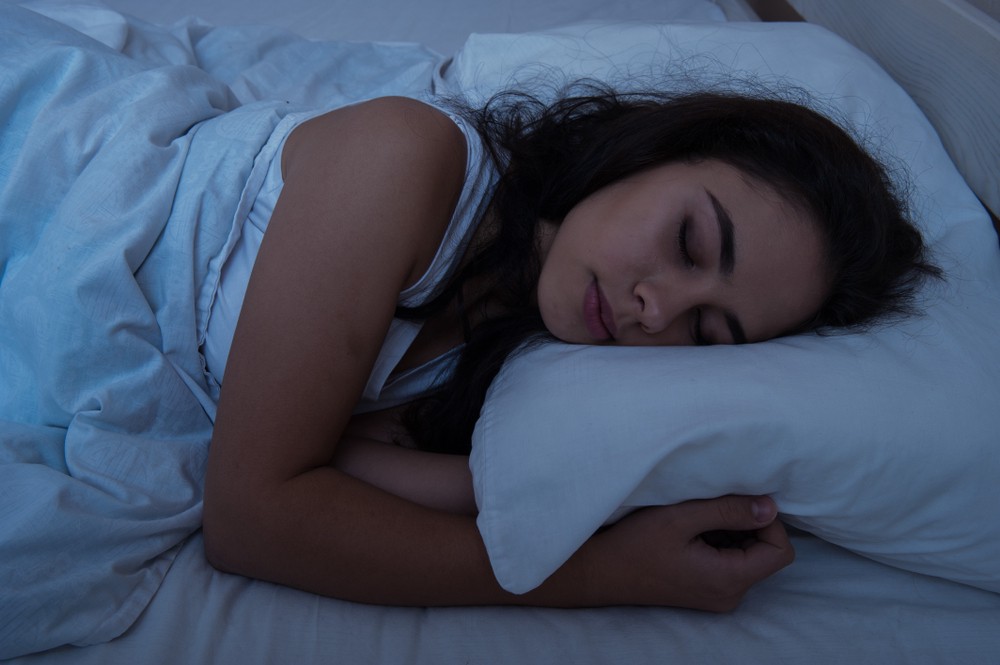 Image Source: Shutterstock, purchased for usage
Image Source: Shutterstock, purchased for usage
Getting adequate sleep is imperative for good health. Sleep occupies a significant position in our lives because it aids the body in gathering the required energy to function properly. The number of hours and quality of sleep we get dictate how we perform our day-to-day activities. Unfortunately in this day and age, most people don?t get enough sleep, and that affects them in every aspect of their lives.
Be it hectic schedules, toxic work environments, or misunderstandings in relationships, whatever negative happens around us causes a large amount of stress. In order to combat the ever-increasing worries, people spend a huge amount of money and energy so that they can make their health better. What they often don?t realize is that all they need is a good night?s sleep to feel much better. And one of the easiest and most effective ways to get deep-sleep is engaging in meditation and yoga just before going to bed.
Benefits of Yoga for Sleep
Both yoga and meditation have been an integral part of Indian culture for a thousand years. They go hand-in-hand and have been used as an alternative form of exercise to keep the mind and body healthy and happy. Practicing yoga improves balance, flexibility, endurance, ability and strength, while meditation facilitates to keep the mind sharp, relieves anxiety and stress, and can strengthen our immune system.
But there are myths about how Yoga should be included a morning routine and should not be practiced in the absence of sun. In reality, this seems to be debatable. Many people actually practice yoga during the evening and night to get away from the constantly fluctuating thoughts of the entire day and to feel refreshed.
While it may seem like an easy practice, if not done properly, yoga can negatively impact one?s health. So knowing what to do and what not to do when engaging in yoga is important.
Thus, in the next section, we?ve compiled a list of do?s and don?ts of practicing yoga before going to bed. This is aimed at helping you focus on the positives, and stay away from the negatives.
The do?s of Yoga before bed
With global stress levels increasing, many people suffer from sleeping disorders like sleep apnea, insomnia, oversleeping, etc. While medication is one solution to such issues, a less-toxic approach is practicing yoga before bedtime to relax the mind.
Yoga has the ability to lower the cortisol levels in the body and curb tension, both of which are extremely high in people who suffer from anxiety or depression. Yoga stimulates the parasympathetic nervous system, which in turn helps people to feel relaxed in the mind and body, resulting in a deep-sleep. There are many other advantages to yoga, such as better energy metabolism, better immune function and more insulin secretion.
By performing all its scientific functions, Yoga renews the entire body. And there are two ways that it does this:
- It facilitates toxin production
- It helps in increasing the oxygen supply to the body
Toxins are often usually contained in organs and tissues and yoga helps set them free through a breathing exercise called Pranayama. It recharges the body and increases the circulation of oxygen, thereby renewing the body and all of its strains to help in getting a good night?s sleep.
Yoga calms the mind and provides mental clarity
 Image Source: Shutterstock, purchased for usage
Image Source: Shutterstock, purchased for usage
It is undeniable that apart from maintaining the immune system of the body, yoga facilitates people with a sense of calmness. The combination of body movements, holding poses and breathing exercises, is a tremendous method to calm the mind. Yoga can also empty out the mind or at the very least, settle it. Doing yoga before bedtime permits the toxins to be released, which helps to calm a disturbed mind and takes daily stress off of the body. It not only prepares us to shut our eyes physically but also mentally.
Often people have trouble sleeping because they have something on their mind that is keeping them awake. This could be work-related, financial, relationship problems or planning for the next day. Doing yoga before bedtime, relaxes the body and stops the mind-chatter. Slow breathing helps to retain memory by keeping the thoughts more organized.
Yoga eases muscles and joint pain and improves breathing

It is extremely important to ease muscles and get rid of any joint pain, if any, before going to sleep. Stretching before bed is a fantastic way to attain this. It usually happens that after a long day at work, the body will encounter night time aches. This issue is mainly faced by elderly people or the ones who work on their feet or sit at a desk the entire day. One of the major benefits of yoga for sleep is that the muscle tension is released rendering a deep-sleep.
An added reward of practicing yoga before hitting the pillow is to do away with things like snoring and sleep apnea. The reason behind these problems is incorrect breathing. It can be over-breathing or fast breathing. Stress, sinus problems, obesity or circulation problems are the primary causes of snoring, while sleep apnea is a common symptom of people who are normally tensed, nervous, or suffering from a lung disorder. Yoga breathing techniques may combat both the problems resulting in a better night?s sleep.
Yoga poses for better sleep
Practicing specific yoga poses before bedtime helps to get a night of restful sleep and allows people to feel refreshed in the morning. The great thing about these poses is that they involve comfortable positions, and one can easily do them in bed.
- The first pose is related to Supine Spinal Twist, which stretches the back and the spine and helps in releasing stress. It quiets the mind and stimulates the kidneys, intestines and abdominal organs.
- The second pose is all about calming the brain and relieving stress and fatigue. The name of this asana is Bal asana which means child pose. It stretches the hips, thighs and ankles. But this pose is not advisable for people suffering from knee injuries.
- The next one is Reclining Goddess Pose. As the name suggests, it is a classic restorative pose which calms the nervous system and improves blood circulation. It also stimulates the heart and therefore relieves symptoms of stress and mild depression. Both of these symptoms contribute to sleep deprivation.
There are two other poses which can contribute to enhancing sleep quality.
- The former is an ailment for many things like insomnia, stress, anxiety, menstrual cramps, menopause, headaches; even tired and cramped legs can be cured by using this pose. The name of this powerful night yoga pose is Viparita Karani ? Legs-Up-The-Wall Pose. Besides improving blood circulation, it stretches the back of the legs and torso.
- The other pose we?re talking about is Savasana ? Corpse Pose. This pose rejuvenates the body, mind and spirit by letting go of all tension. It gets rid of the stresses of the day, promotes and enhances inner awareness and eases the entire body from head to toe. Apart from these many benefits, it decreases blood pressure, metabolic rate and oxygen consumption, increases focus, concentration and energy levels.
Now that we?ve seen all that can be done when practicing yoga at night, let?s take a look at what all should be avoided.
The don?ts of Yoga before bed
Yoga is a serious practice which usually should be done under the supervision of a trained professional. But many people wish to practice yoga according to their own comfort level. Also, their time of practicing differs according to the availability of time. Therefore, one has to keep a few things in mind and restrain from practicing if any ailment prevails. Following are the key considerations:
Injury Risk
Although Yoga before bed is a decent idea to follow, sometimes, serious injuries such as strokes and nerve damage can occur on rare occasions, especially in the case of women and elderly people. Certain poses are prohibited for blood pressure and glaucoma patients. Few high-end poses are not supposed to be done after dinner as they may result in muscle tears. Complex moves should be avoided in the night time.
Hot Yoga Risks
Yoga routines such as ?Bikram? need a hot environment, often set to 105 degrees F and 40 per cent humidity. Such an environment comes with the risk of dehydration and heatstroke. The night is the time to relax, but instead of relaxing, hot yoga may result in increased anxiety.
Scientific explanation
Another caution to be maintained is that one should practice yoga only 4?5 hours after dinner. If the stomach is full, firstly, practicing yoga with ease is not possible, and secondly, it will bear no results.
Wrapping it up
 Image Source: Shutterstock, purchased for usage
Image Source: Shutterstock, purchased for usage
It is really important to understand what yoga actually does to your body. Yoga only helps you relax your mind and body. It doesn?t involve strenuous work out that has you sweating and leaves you tired. Yoga, is in fact, the opposite; it will help you calm down and relax so that you get better sleep. The breathing exercises or any other asanas that you practice will only help the tension in your body ease out.


